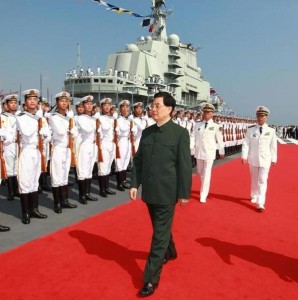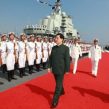
Examining the New Aircraft Carrier through the PLA’s Revolution in “Organizational” Affairs
Publication: China Brief Volume: 12 Issue: 19
By:

With the commissioning of the People’s Liberation Army’s (PLA) first aircraft carrier, more clarity has been provided in terms of the organizational setup of any future PLA Navy (PLAN) carrier strike group. The details emerging about the aircraft carrier Liaoning help illustrate one of the most important elements of the PLA’s decades-long “revolution in military affairs”—the organizational and institutional revolution. David Shambaugh first called for a better understanding of PLA organization in the 1998 RAND study, The PLA in the Information Age, saying, “I would submit that institutional mapping is always necessary, as organizations must be thought of as evolving organisms that need to be carefully tracked” [1]. The field has ably responded with conferences and anthologies on the PLA as an organization, but this author would argue the focus still has largely remained on structure and technical capabilities, whether hardware or the “software” of human capital. The “institutional mapping” of how things get done that Shambaugh refers to has been largely lacking. The application of modern political science tools to what is essentially a learning organization with guns still has a wide horizon to pursue. This article will follow up on one of these questions by looking at the new carrier and putting it in the context of PLAN and PLA joint force structure.
|
Table 1. Rank, Grade and Title in the PLA* |
||
|
Grade |
Navy Position |
Army Position |
|
4. Military Region Deputy Leader (daqu fuzhi) |
Fleet HQ Commander
|
MR Deputy Commander |
|
5. Jun Leader (zhengjun) |
Fleet HQ Deputy Commander |
Group Army Commander |
|
6. Jun Deputy Leader (fuzhi) |
Support Base Commander |
Group Army Deputy Commander / Group Army Chief of Staff |
|
7. Division Leader (zhengshi) |
Flotilla Commander |
Division Commander |
|
8. Division Deputy Leader (fushi) |
Nuclear-powered Submarine Commander |
Division Deputy Commander / Brigade Commander / Division Chief of Staff |
|
9. Regiment Leader (zhengtuan) |
Destroyer Commander |
Regiment Commander / Division Deputy Chief of Staff |
|
Source: China’s Navy 2007, Office of Naval Intelligence. This document can be found at https://www.fas.org/irp/agency/oni/chinanavy2007.pdf.<//span><//span> |
||
A Division-grade Vessel: First among Equals
On September 25, the new captain and political commissar stood on the deck of the Liaoning proudly posing for Xinhua photographers and giving interviews. Captain Zhang Zheng even gave one in perfectly-accented British English for an English-language CCTV program (CNTV.cn, September 25). Both the captain and the political commissar wore lapels with four stars and ribbons with two stars, indicating they were both senior captains of the Navy, second half, meaning they were both division leader-grade (G-7) officers. This places the vessel under their command at the same grade, division-leader (G-7), making the Liaoning equivalent in the PLAN order of battle to a destroyer flotilla (G-7) and a grade above China’s nuclear missile submarines (G-8). This has several implications for the organizational structure of a carrier strike group and its relations with other PLA units.
In October 2011, this author argued the carrier would be a deputy division leader-grade (G-8) vessel, with the offhand chance that it would be placed at division-grade (G-7) due to its importance. This conservatism was based on the estimation that the carrier would be more easily managed if it was within an overall naval tactical formation as then it could report to an overall flotilla commander and operate organically within a flotilla organization (“The PLA’s Evolving Joint Task Force Structure: Implications for the Aircraft Carrier,” China Brief, October 28, 2011). Now, it is clear the carrier will operate in a peer relationship with its escort flotilla, yet it would most likely operate on a “first among equals” basis within the larger structure.
Based on the observations of the PLA’s Lianhe (“Joint”) series of exercises, as detailed in the previous piece, the PLA has developed a nested set of organizations to facilitate communication and interoperability among units of different services. The tactical echelon of this structure is known as the joint tactical formation (lianhe zhanshu bingtuan). Sitting around this table are commanders of the ground force tactical formation (lujun zhanshu bingtuan), naval tactical formation (haijun zhanshu bingtuan) and air force tactical formation (kongjun zhanshu bingtuan). The grades of the constituent units vary, but are no higher than division leader-grade (G-7). As seen in multiple Lianhe exercises, these various unit commanders rotate the “chairmanship” of the joint tactical formation based on phases of an operation, such as the air commander during dockside loading, the naval commander during ocean transit and the ground commander during beach landing (PLA Daily, September 12, 2007).
Now, with the Liaoning commanding officer identified as a division-grade officer, analysts have an idea of how the tactical echelon would be composed. The analysis here presumes no “mirror imaging” of U.S. Navy organizational structure or behaviors, but rather is based on the development of the PLA’s own joint organizational structure. The carrier would have to be able to link up with or into such a structure, even if it ever operated only with other Navy units in its career. As a division-grade (G-7) peer, the Liaoning would be its own naval tactical formation with a second naval tactical formation composed of its escort flotilla also at the table. Having two tactical formations of the same service is not unprecedented within joint tactical formations. Given the prestige of the carrier and the central role it would play in any task force composed around it, Captain Zhang probably would serve as the head of the joint tactical formation for most or all of the operation. So while he would be equal grade to his escort flotilla commander, as head of the umbrella joint tactical formation, he would be able to direct the flotilla commander as he saw fit.
A Subordinate Air Wing
The previous analysis noted, when the PLA Air Force previously has operated jointly with the PLA Navy, it has been represented by regiment-leader grade (G-9) officers as compared to division leader-grade (G-7) interlocutors (“The PLA’s Evolving Joint Task Force Structure: Implications for the Aircraft Carrier,” China Brief, October 28, 2011). The establishment of the Liaoning as a division-grade vessel and the likelihood that an embarked naval aviation air wing would be two grades below it strongly suggests the CAG-equivalent would report directly to the ship captain rather than to an overall strike group commander. Reporting on air wing operations remains scant, so this hypothesis is in particular want of more data before it can be accepted or disproven.
The significance, however, is that the air wing commander will be a subordinate officer to the ship captain and political commissar. This in effect means the division-grade carrier will be a combined naval-air tactical formation with organic naval and aviation elements. How this impacts relations with PLAN aviation assets ashore or even PLA Air Force assets also remains to be seen. At first gloss, however, it appears that the air force tactical formation commander will not have exclusive ownership of all aviation assets in a joint operation with the carrier task group. That is to say, the embarked aviation elements will be operated separately from the air force tactical formation’s operations, such as strategic air cover or reconnaissance.
The Carrier Strike Group Commander
Perhaps the most important role in any carrier operations, however, is not that of the vessel captain or air wing commander, but the commanding officer of the carrier strike group. In the PLA series of nested joint organizations, the joint campaign formation (lianhe zhanyi juntuan) is the next level up from the joint tactical formation. The constituents of joint campaign formations also vary in grade, but are no higher than corps (jun) leader-grade (G-5). Previously, this author suggested the carrier strike group commander would be in effect the chair of the joint campaign formation, so thus would have to occupy a Grade 5 position. In the PLAN, this includes fleet deputy commanders or the fleet chief of staff. Seeing as how a chief of staff would be needed ashore, the most likely candidate to go to sea commanding a carrier strike group would be a fleet deputy commander, specifically for the Liaoning, a North Sea Fleet deputy commander. There are several qualified candidates within the North Sea Fleet from which to choose.
We perhaps would be left guessing as to which deputy fleet commander it would be, except for some fortuitous reporting and Chinese crowd sourcing. A Chinese-language report indicated the “formation commander” had been selected and while not naming him, indicated he had, “served for a long time in the South Sea Fleet, indeed as a South Sea Fleet destroyer flotilla commander and also worked in the Navy Command Department” (Oriental Morning Post, September 26). Internet commenters zeroed in on one particular candidate, Yang Junfei, a North Sea Fleet deputy chief of staff (G-6) with the requisite background details, including commanding a South Sea Fleet destroyer flotilla (Feiyang Junshi, Fyjs.cn, September 26). While not all responses agreed this was the man, a search for Yang Junfei in the PLA Daily shows an impressive record of service. He most recently served as commander of the PLAN’s 11th escort mission task force in the Gulf of Aden, composed of the guided missile destroyer Qingdao, the missile frigate Yantai and supply ship Weishan Hu from the North Sea Fleet (China News Service, February 27).
The problem of his grade being below what was predicted for joint campaign formation commander also was solved sometime in early 2012. Listed as a deputy chief of staff (G-6) of the North Sea Fleet in February 2012, by March he was referred to as “deputy commander of the North Sea Fleet” (G-5) (PLA Daily, March 2; China Military Network, March 11). Ultimately, what is important is not necessarily the individual named to the position, but the contention that the carrier formation commander will be a Grade 5 officer of the North Sea Fleet. Yang may fit the bill, but so do others. Still, his recent return with the 11th Gulf of Aden escort task force to Qingdao coincides with suggestions from Chinese experts that the Liaoning will be berthed in Qingdao, where deep waters and ample anchorages can accommodate the multiple ships of a carrier task force (Southeast Commercial News, September 26).
Looking Ahead
In looking at the history of PLA joint training and how the Liaoning fits into that landscape, one cannot help but notice coincidences. As Andrew Erickson and others have noted, not naming the ship Shi Lang after the Qing admiral that conquered Taiwan was significant, and “Liaoning” honors the province in which the ex-Varyag was refitted (Wall Street Journal, September 25). To add to the significance, one can look to the passage of the joint training torch from Jinan Military Region in 2008 to Shenyang Military Region, which includes Liaoning province and the port city of Dalian. Now, with the organizational structure of the aircraft carrier emerging in what seems to be the form predicted by Jinan Military Region’s Lianhe exercises and with the eventual home port located in Jinan Military Region’s port city of Qingdao, the Liaoning can be said to be fulfilling a virtuous cycle of training development currently entering a new iteration of experimentation. Perhaps this next phase of PLA training innovation will emerge from its cradle in and around the green waters of the Bohai Sea and into the bluer waters of the open ocean.
Notes:
- David Shambaugh, “PLA Studies Today: A Maturing Field,” in James Mulvenon and Andrew Yang, eds., The People’s Liberation Army in the Information Age, Santa Monica, CA: RAND, 1998, p. 20.





